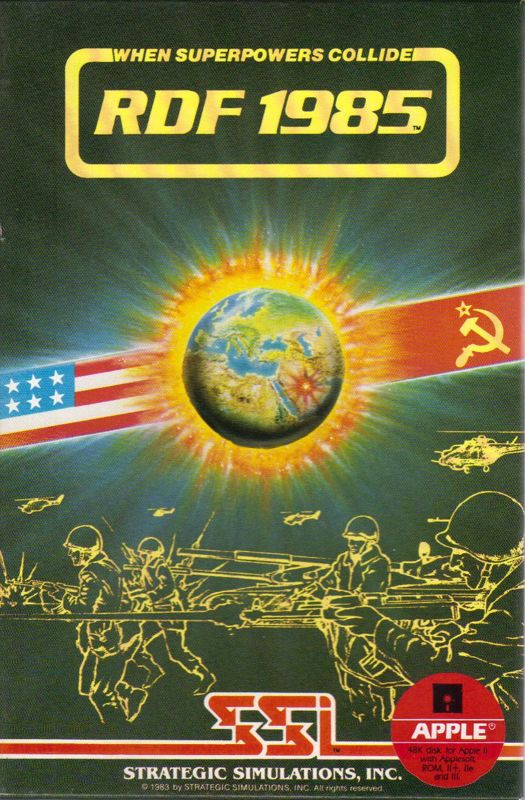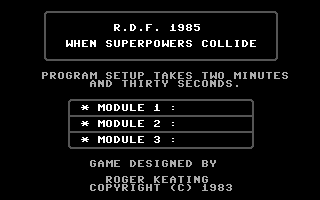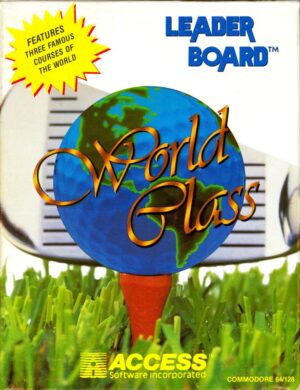Retro Replay Review
Gameplay
RDF 1985 offers a finely tuned strategic simulation that puts players in command of the United States’ Rapid Deployment Force as it races to reclaim vital oil fields from Soviet paratroopers. The single-scenario structure concentrates all of its depth into one intense campaign, demanding precise planning and adaptive tactics over a set number of turns. Every move counts: deploying mechanized infantry, coordinating air support, and securing key towns become critical decisions that will tip the balance of power.
(HEY YOU!! We hope you enjoy! We try not to run ads. So basically, this is a very expensive hobby running this site. Please consider joining us for updates, forums, and more. Network w/ us to make some cash or friends while retro gaming, and you can win some free retro games for posting. Okay, carry on 👍)
The turn-based mechanics are easy to learn but difficult to master. Each side has its own strengths—Soviet forces excel in numbers and initial surprise, while the RDF boasts superior mobility and air superiority. Managing supply lines and timing your counterattacks feels organic, as the map’s hex-based design reveals vulnerabilities and choke points. Veteran wargamers will appreciate the layers of strategy, while newcomers can enjoy the straightforward victory condition: control the most towns and oil fields by turn’s end.
One notable feature is the fog of war, which adds tension to every reconnaissance mission. Players must weigh the risk of sending in scouts versus consolidating defensive positions. The scenario’s pacing keeps engagement high, with each turn bringing new opportunities and threats. Although there is only one scenario, its depth and replayability stem from experimenting with different force compositions and movement patterns.
Graphics
For a mid-1980s release, RDF 1985 delivers clean, functional graphics that emphasize clarity over flash. The hexagonal grid is crisply outlined, and unit icons are easily distinguishable, color-coded to differentiate U.S. forces from Soviet units. Terrain features such as deserts, towns, and oil fields are represented with simple yet effective symbols, making it immediately apparent how geography will influence your strategy.
Animations are minimal but purposeful. Paratrooper drops, mechanized advances, and airstrikes are represented with brief, discrete markers on the map. This streamlined approach ensures that the focus remains on tactical decision-making rather than visual spectacle. The occasional animation of a town changing hands or an oil field being captured provides just enough feedback to keep the battlefield feeling alive.
While modern gamers might find the visuals rudimentary, there’s a certain charm in the retro aesthetic. RDF 1985’s interface is intuitive: menus are accessible, and tooltips provide necessary unit statistics without cluttering the screen. For enthusiasts of classic wargames, the graphics serve their purpose perfectly, reinforcing the strategic atmosphere and period setting without distraction.
Story
Building on its predecessor Germany 1985, RDF 1985 continues the “When Superpowers Collide” series with an alternate-history scenario that pits NATO against the Warsaw Pact on two fronts. The narrative backdrop is succinct but compelling: as Soviet forces engage in Germany, a daring airborne operation targets Middle Eastern oil fields, threatening global energy security. The United States responds by deploying its Rapid Deployment Force to neutralize the threat and regain control.
Although there is no sprawling campaign narrative or character development, the premise provides enough context to drive the action. Every turn underscores the high stakes involved: an oil field captured or a town lost can shift the geopolitical balance. The straightforward victory conditions—control the most towns and oil fields—tie directly into the strategic narrative, making each decision feel meaningful.
RDF 1985 excels at conveying tension through its setup rather than through cutscenes or dialogue. The urgency of the scenario is palpable, and players quickly become invested in the ebb and flow of territorial control. While fans of story-heavy games might crave more exposition, those who appreciate pure strategy will find the narrative framework perfectly suited to the gameplay.
Overall Experience
RDF 1985 stands out as a focused, challenging wargame that rewards careful planning and tactical flexibility. Its single-scenario design might seem limiting at first, but the depth of strategic choices ensures that no two playthroughs feel identical. Whether experimenting with pincer movements in the desert or establishing strong defensive lines around oil fields, players will find plenty of opportunities to test their skills.
The game’s strengths lie in its streamlined interface, clear presentation, and tightly balanced mechanics. RDF 1985 doesn’t overextend itself with unnecessary features; instead, it delivers a core experience that is both accessible and rewarding. Even decades after its release, it remains a worthy entry in any strategy enthusiast’s library.
Potential buyers looking for a rich, turn-based conflict simulation set against a Cold War backdrop will find RDF 1985 to be an engaging and intellectually satisfying title. Its blend of historical premise and tactical gameplay makes it a standout example of 1980s wargaming at its best, offering enduring replay value for those willing to delve into its strategic depths.
 Retro Replay Retro Replay gaming reviews, news, emulation, geek stuff and more!
Retro Replay Retro Replay gaming reviews, news, emulation, geek stuff and more!









Reviews
There are no reviews yet.